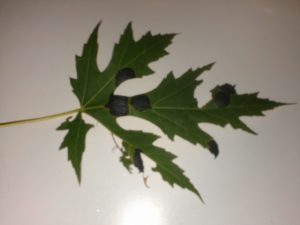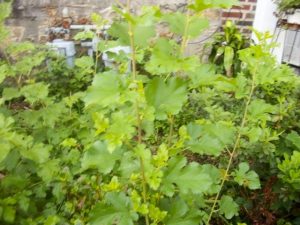Q. We have several maple trees in our neighborhood afflicted with this black spot (see attached photo) last year. We’re looking for information on cause, prevention, health risk factors (to the trees), treatment and long-term prognosis for the infected trees.
A. While I can’t confirm a diagnosis from this photo alone, a fungal disease called tar spot would be a good guess. Tar spot is a common disease on silver maple and is primarily considered to be a cosmetic problem rather than a serious threat. The Purdue Plant and Pest Diagnostic Laboratory has additional information on tar spot at http://www.ppdl.purdue.edu/PPDL/weeklypics/1-19-09.html.
To confirm a diagnosis, you can bring a sample to your Purdue Extension office in your county. Find contact information at http://www3.ag.purdue.edu/counties/. Or you may submit a sample directly to the PPDL. See http://www.ppdl.purdue.edu for instructions.
Q. I am looking for some information on what I believe is a mulberry plant. When we recently moved, we discovered that our dog kept going over to eat this particular plant – no other ones, just this one. We had no idea what it was or if it was good for her. We had heard that dogs liked certain plants so we thought it was OK. Regretfully, our upstairs neighbor decided to chop it down and, although it grew back, I’m wondering if there is anyway to root it and grow it as a houseplant?
A. Your plant certainly looks to be a mulberry. It is notoriously weedy and, as you’ve already observed, cutting it back will usually result in its resprouting. Cuttings from the twig tips will likely root any time during the growing season, but you could use rooting hormone from a garden center to increase the rooting.
However, I recommend that you not allow your dog to continue munching on the mulberry. Mulberry has a white, milky sap that can cause irritation or allergic reactions. Dogs and other animals will eat plants that can make them ill or worse, so I would not rely on the dog’s judgment! Please consult your veterinarian before allowing your dog to eat plants.

